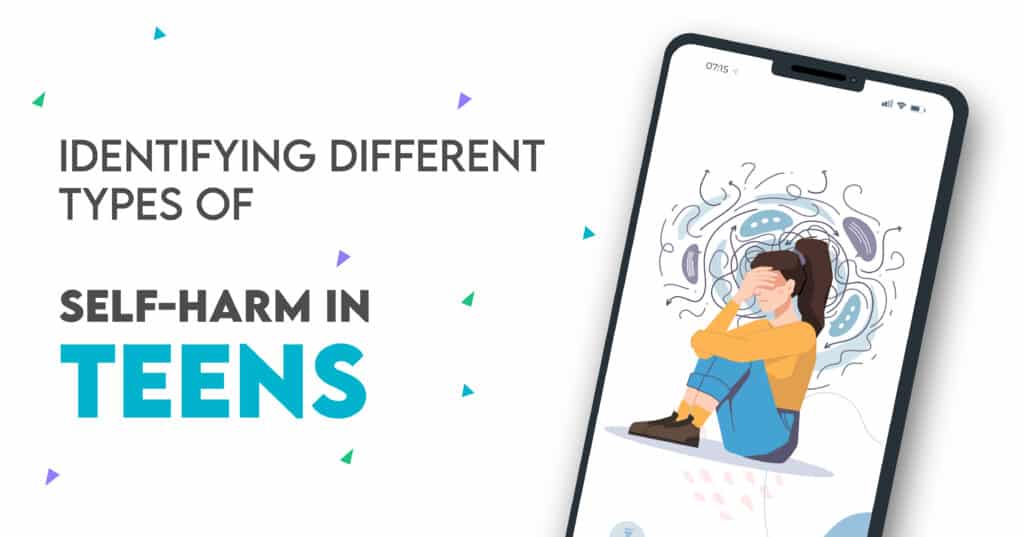Self-harm is defined as intentionally injuring or hurting oneself. Self-harm, also known as self-injury, is a symptom of severe emotional distress. Teens engage in a variety of self-harm behaviors that can be difficult to recognize or identify.
Unfortunately, this type of behavior is becoming more common in teenagers. According to a recent analysis of data from the Centers for Disease Control, up to 30% of teenage girls and 10% of boys have intentionally injured themselves. According to one study, up to 25% of young people engage in self-harm.
These rates have risen dramatically in the last decade, particularly among girls. Self-injury increased by 166 percent in girls aged 10 to 14, and by 62 percent in girls aged 15 to 19. The majority of these increases involve cutting, the most common form of self-harm. Since 2009, the rate of younger girls cutting has increased by 18.8 percent per year.
Teenagers and Self-Harm: Why They Do It
Why do adolescents cut themselves or engage in other forms of self-mutilation? Teens who cut or burn themselves are not suicidal. They instead use self-harm as an unhealthy coping mechanism to deal with difficult emotions.
Self-harm is a way for teenagers to express their pain, tension, and anxiety. Anger, shame, grief, guilt, and self-loathing are examples of painful emotions. They use self-injury to feel more in control of their emotions or to distract themselves from their emotions or life circumstances. Furthermore, they may self-harm in order to punish themselves for what they perceive to be flaws or faults.
Furthermore, teens may injure themselves because the physical pain of self-harm appears to be preferable to the numbness and emptiness that accompany depression. Thus, cutting and depression are often linked.
Self-injury may provide a brief sense of calm and release of tension. However, the painful emotions return quickly. Some teenagers will self-injure a few times and then stop. Others, on the other hand, occur repeatedly over a long period of time. Therefore, self-harming can turn into a compulsive behavior.
Is Self-Harm a Mental Illness?
Self-harm or self-injury is not a mental illness. It is, rather, an unhealthy coping mechanism related to an underlying mental health condition. Self-harming is linked to borderline personality disorder, depression, eating disorders, anxiety, and PTSD. Additionally, teens who harm themselves frequently do so while under the influence of alcohol or drugs.
Self-harm is most common among teenagers and young adults. Some experts believe that teens who have experienced trauma, neglect, or abuse or at higher risk.
While not considered a suicide method, self-harm in adolescents may be associated with an increased risk of suicide. According to one study, up to 70% of teens who self-harm have attempted suicide before, and 55% have attempted suicide multiple times. As a result, cutting and other forms of self-harm must be treated professionally as soon as they are discovered.
Peers, Social Media, and Self-Harm
Self-harm is typically done by teenagers in private. They may, however, use self-injury to connect with others who are also distressed and in pain. Furthermore, teens who have friends who self-harm are more likely to attempt it themselves. Furthermore, teens seeking relief from painful emotions can easily find information online about various types of self-harm.
In other ways, technology may be linked to self-harm. Most importantly, research shows that teenagers’ use of social media increases their unhappiness. As a result, experts believe that teens’ increased use of technology over the last decade may be linked to the rise in self-harming behavior. Furthermore, girls use social media more frequently than boys, and they self-injure more frequently.
Furthermore, time spent on digital media consumes time spent on healthier activities such as sleeping, exercising, or spending time in nature. As a result, teens have fewer opportunities to develop positive coping strategies.
According to recent research, depressive symptoms and suicide rates among adolescents increased between 2010 and 2015, particularly among females. Teens who spent more time on social media and smartphones were also more likely to disclose mental health issues. Furthermore, adolescents who spent more time doing non-screen activities like face-to-face social interaction, sports and exercise, homework, and reading print media were less likely to report mental health problems.
What Are the Different Types of Self-Harm?
Self-harm does not all look the same. Cutting with a knife or other sharp object is one of the most common types of self-harm. Teens frequently cut themselves as a ritual, leaving patterns on their skin. They might etch words or symbols into their skin.
But teens also use different forms of self-harm, including one or more of the following:
- Skin scrubbing, biting, or burning
- hitting or punching themselves or the walls
- Using sharp objects to pierce their skin
- Hair pulling
- Picking at wounds and scabs
- Introducing foreign objects into the body
- Excessive drug use or excessive drinking
- Exercising to the point of collapsing or injuring oneself
- Getting involved in fights where they are likely to be injured
- slamming one’s head or body against a wall or other hard object
- Having dangerous sex.
Self-Harm Symptoms
Parents and other adults who work with teenagers should be aware of the red flags associated with various forms of self-harm. Here are some signs and symptoms that a teen may be self-harming:
- Unknown cuts, scratches, bruises, or other wounds, frequently on the wrists, arms, thighs, or torso, which they explain away as the result of accidents
- Keeping sharp objects nearby
- Wearing skin-covering clothing, such as long sleeves or long pants, even in hot weather
- Instability and impulsive behavior
- Having feelings of worthlessness or hopelessness
- Relationship difficulties
- stains of blood on bedding, clothing, towels, or tissues
- Having razors, safety pins, nail scissors, knives, needles, shards of glass, or bottle caps in their possession
- Spending extended periods of time alone, typically in the bathroom or bedroom
- Increased social withdrawal and isolation
- Avoiding situations that require them to expose their skin, such as swimming or changing in a locker room.
Complications and Consequences of Self-Injury
Self-harm can have serious, even fatal, health consequences. Furthermore, it can have a continued negative impact on mental health.
Possible complications of self-harm include:
- Shame, guilt, and low self-esteem are all on the rise.
- Infections of the wound
- Scarring or disfigurement that is permanent
- Bone fractures
- Isolation leads to the loss of friendships.
- Significantly increased risk of major depression, drug and alcohol addiction, and suicide.
What to Do When a Loved One is Self-Harming
When a loved one is self-harming, the most important goal is to encourage them to seek treatment. Parents or guardians should take the necessary steps to get their child or teen professional help. A good place to start is with your pediatrician.
Teenagers who have friends who are self-harming should encourage them to talk to their parents, a school counselor, a teacher, or another trusted adult.
As a result, family and friends can help loved ones in a variety of ways. First, even if you are scared or confused, do not be angry with your loved one. Threats, yelling, and criticism will not help. In fact, they may increase the likelihood of future self-mutilation.
Face your own discomfort or confusion about self-harming as well. Furthermore, educate yourself on this behavior and why it occurs. As a result, you can learn about the symptoms, various types of self-harm, underlying issues, and how to help prevent relapse.
Also, remember not to pass judgment on the individual. Most likely, they already feel distressed and ashamed. No matter what, express your concern and support. Let the person know you are willing to talk about what they are going through if they want to. Find ways to spend time together doing healthy, positive activities as well.
Treatment for Self-Harming Behavior
Treatment for self-injury focuses on the underlying causes of the self-destructive behavior. As a result, anxiety or depression treatment may be required. Low self-esteem, dysfunctional family dynamics, or other mental health conditions such as borderline personality disorder could all be underlying issues.
In addition, teens learn new coping mechanisms for dealing with difficult circumstances or painful emotions. Treatment helps them stop self-harming behaviors by substituting healthier behaviors such as breathing exercises and compassionate self-talk.
Residential or outpatient treatment may be appropriate for some adolescents who injure themselves. Therapists may provide one or more of the following modalities to address various types of self-harm.
Cognitive Behavioral Therapy (CBT): Cognitive Behavioral Therapy (CBT) assists adolescents in identifying and changing thought and behavior patterns. As a result, they learn how to shift their perspective from negative to positive and how to identify triggers for self-harm.
Dialectical Behavioral Therapy (DBT): Dialectical Behavioral Therapy (DBT) assists teens in recognizing that they are self-harming to cope with underlying issues. They then devise methods to modify this behavior. In addition, they address the root causes of self-harm.
Meditation and yoga: A growing body of research indicates that mindfulness meditation can benefit mental health. Meditation encourages us to observe our emotions from a distance rather than becoming consumed by them. As a result, adolescents learn to cope with their emotions and manage their distress without self-harm. Indeed, a review study at Johns Hopkins discovered that meditation was just as effective as antidepressants in treating anxiety and depression symptoms.
Replacing Self-Injury with Positive Coping Skills
Here are some effective strategies for assisting teenagers in replacing self-harm with positive experiences. Furthermore, these various methods for preventing self-harm will assist teenagers in developing self-esteem and authentic connections.
Social Support: Multiple studies have found that social relationships improve both mental and physical health. The more help we have, the more resilient we become. Teens who self-injure will benefit from finding people they can trust who care about their situation. Family, peers, guidance counselors, and mentors can all be part of their support network.
Unplugging: Unfortunately, teens who self-harm may come across websites that encourage or glorify their behavior. As a result, they are dragged back into the habit. Thus, teens who engage in various forms of self-harm should unplug as much as possible. Furthermore, reducing digital media activity will benefit overall mental health.
Exercise: Studies show that exercise improves mental health by increasing endorphin production in the body. These are the “feel good” chemicals in the brain. Moreover, doing a physical activity can increase a teen’s feelings of mastery and self-confidence. As a result, they feel less of an urge to self-harm.
Take Charge: For some people, gathering information and making plans can help them cope with stress and negative emotions. If a large project is looming, teens can make a schedule to keep them on track. If they’re facing an unknown situation, they can do some research so they know what to expect. As a result, teens can reduce their feelings of being out of control. As a result, self-harming behavior decreases.
Creative Projects: Writing, art, music, and dance are all forms of creativity that can be used to express emotions. Writing about what causes stress and anxiety in your life, for example, can help you identify outside stressors. Furthermore, it can assist you in determining what is going on internally.
What to Do in an Emergency
In conclusion, while self-harm is not the same as a suicide attempt, it can be life-threatening. Therefore, take these emergency actions if someone is actively self-harming:
- Do not leave the person alone.
- Remove anything that could be used in a suicide attempt, including firearms, alcohol, drugs, razors, or other sharp objects.
- Call the US National Suicide Prevention Lifeline at 1-800-273-TALK (8255).
- Take the person to an emergency room or seek help from a medical or mental health professional.





